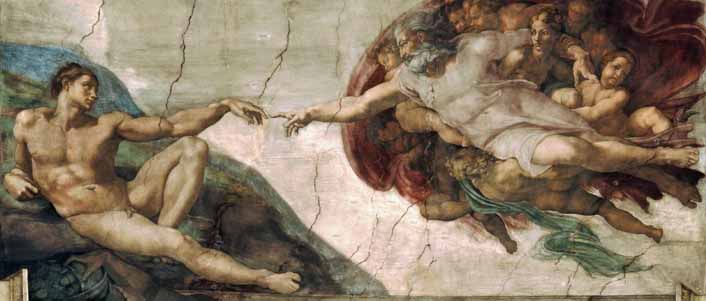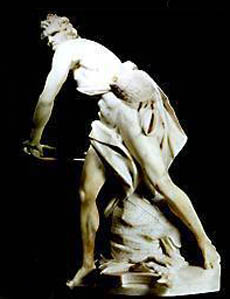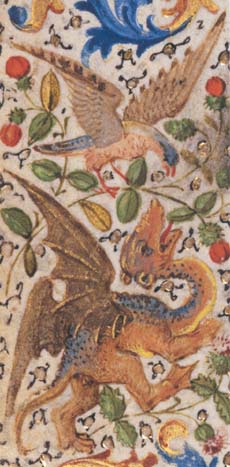
The Creation of Adam, by Michaelangelo
The Renaissance
The Renaissance, or rebirth, was caused by the rediscovery in the twelfth century of the main body of Aristotle's thought. This led to a renewed interest in this-worldly concerns, in a rational metaphysics, in the supremacy of reason over faith and a growing interest in selfish values rather than religious sacrifice. The arts, too, reflected the new conception of man as noble, heroic and efficacious. Men's confidence in their ability to understand the world grew, the idea of progress showed up for the first time and was shortly confirmed by new sciences that gave man control over nature. Political systems were slower to shake off the acceptance of tyrany.
- The Renaissance in 2 minutes – The entire history of the Renaissance is summarized in this 2-minute video by Scott Powell.
- A World Lit Only by Fire, The Medieval Mind and the Renaissance by . The author illustrates and explains the medieval mind, characterized by its "staggering mindlessness," which persisted without improvement or much change for nine hundred years, which lack of rationality left all of Christendom in a condition of bizarre superstition, brutal subsistence and early death. Out of this dark age, the rediscovery of Greek virtue, particularly in the form of Aristotle, gradually brought an interest in rationality and living on earth back to men. This flowered in the Renaissance, as artists and intellectuals championed the Greek virtues, setting the stage both for reactionary responses of the Reformation and Counter-Reformation, and -- ultimately more important -- for the eventual philosophic and political revolutions of the Enlightenment.
- The Renaissance, A Short History by . A brief history of the main ideas, events and actors in the Renaissance, the rebirth of reason and rediscovery of the Greek outlook on life and man.
- Prince Henry: The Navigator by . What sets this work apart is that it is genuinely accessible to the first time reader of history, without being simplistic or childish. It is well structured, and written in a clear, flowing style. At only 51 pages in length--including ample and perfectly selected images--you can read it in one sitting. But then you can return to it to even greater advantage, because despite it's small size, this book is packed with good stuff.
- The Civilization of the Renaissance in Italy by . A (19th-century) classic. Still widely read today.
- On Painting by . Alberti was the archetypical renaissance man: poet, scholar, architect, humanist, theorist and dashing figure. Here, Alberti has written the first modern book combining artistic theory and practice.
- Leonardo da Vinci by Sherwin B. Nuland. Leonardo was the most extraordinary thinker of the Renaissance, demonstrating the heights of human achievement possible and the necessity and benefits of independence in thinking.
- The Discovery of America by . Fiske's "The Discovery of America" (2 vols.) has given me a deeper appreciation of the true place of Columbus in world history. (out-of-print, see sources.)
Links
- Creating St. Peter's – The exhibit, on loan from the Vatican, traces the life of St. Peter's Basilica from the 5th through the 17th centuries and charts two of the greatest architectural feats of the Renaissance: the engineering and construction of the dome of St. Peter's Basilica, and the relocation of the Vatican obelisk to St. Peter's Square. The exhibit's centerpiece is Michelangelo's 18-foot wooden model for St. Peter's dome, intricately detailing both the inside and the outside of this 500-year-old architectural masterpiece.
- History Recommendations from Scott Powell – History reading recommendations from Scott Powell
- Leonardo da Vinci – Leonardo Exhibit at the Boston Museum of Science
- Leonardo da Vinci Museum in Milano
Credits
- Contributor: Steve Jolivette
copyright © 2024 Andrew Layman, all rights reserved, 1/15/2024 6:09:27 PM, Topic: Renaissance, http://www.strongbrains.com


